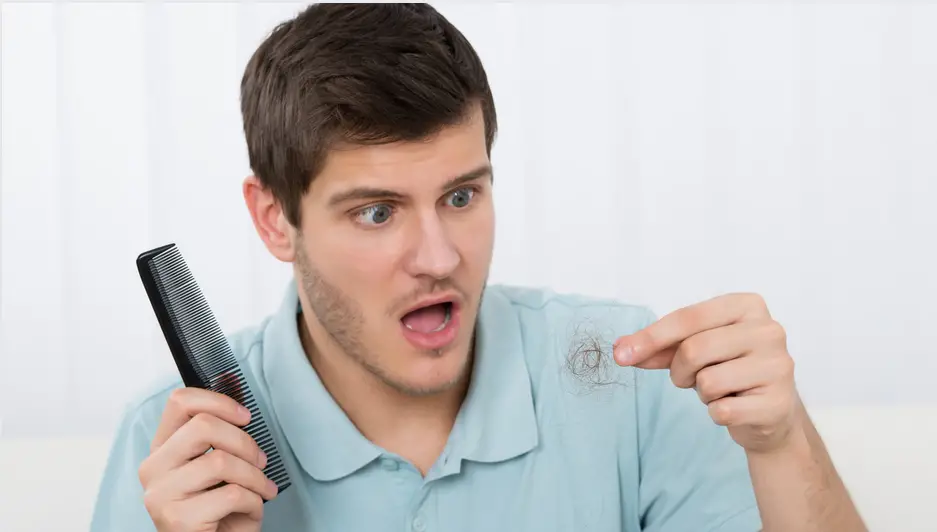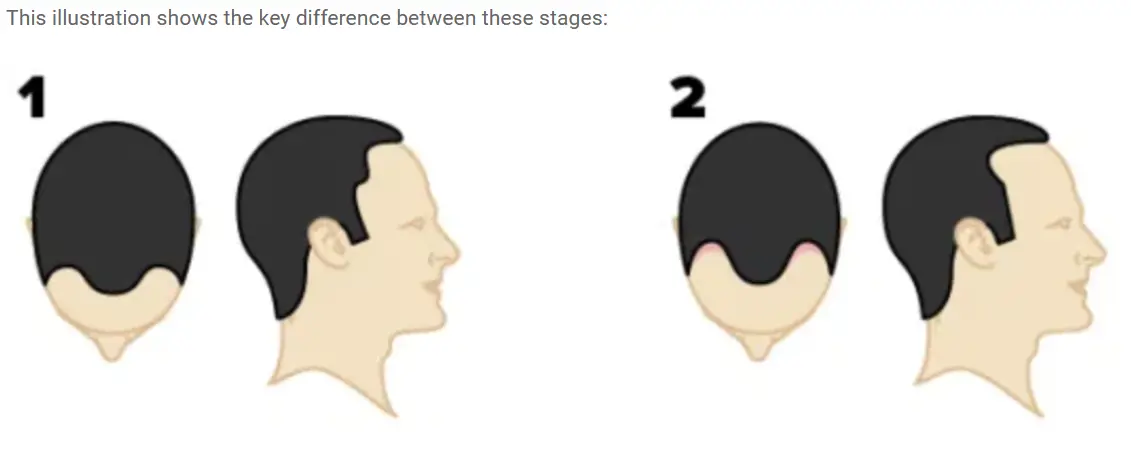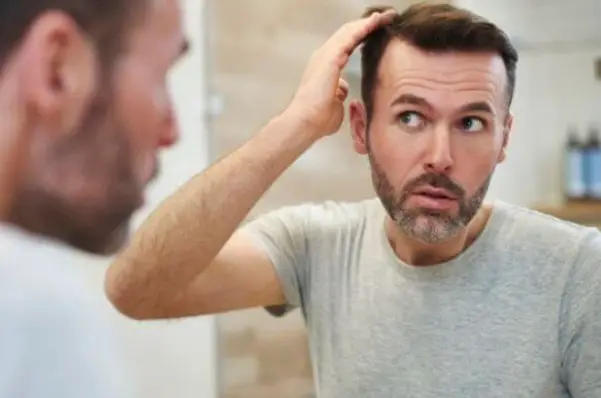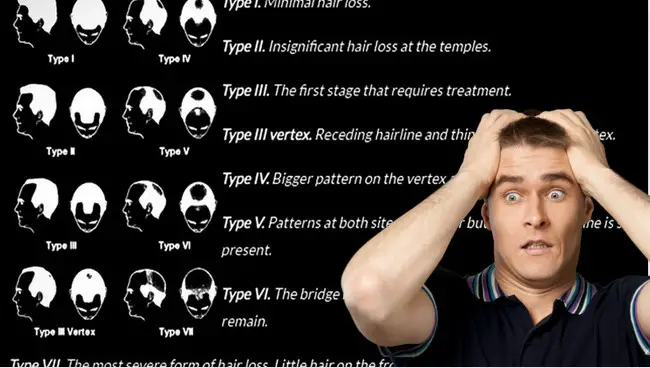Hair loss can be a daunting experience for many, often leading to questions and concerns about the stages of balding. This is where the Norwood Scale comes in as an essential diagnostic tool that classifies male pattern hair loss into seven distinct stages.
If you’re noticing subtle changes in your hairline, it’s crucial to understand if what you’re experiencing is Norwood Stage 1 or another stage altogether. In this blog post, we will delve into Norwood Scale Stage 1 – whether it’s considered actual balding, its causes, treatment options available, and how best to care for and maintain healthy hair at this stage. So sit back and keep reading; our comprehensive guide will shed light on all your pressing questions about Norwood 1 Balding.
Understanding The Norwood Scale And Male Pattern Baldness
The Norwood Scale is a system used to measure male pattern baldness into different stages, which helps in determining the appropriate hair restoration treatment for each stage.
What Is The Norwood Stage 1 Hair Loss?
Norwood stage 1 hair loss represents the earliest and most subtle indication of male pattern baldness. At this point, the hairline may show minimal recession, typically along the temples. For many men, stage 1 is often not a major concern since it can be viewed as a natural transition from adolescent to mature hairline.
However, it is essential to monitor any progression in hair loss closely from here on out. Not all men who experience Norwood stage 1 will progress further down the scale or face significant balding. It varies based on genetic factors and other underlying causes of hair loss. Meanwhile, some might argue that having Stage 1 hair loss doesn’t necessarily qualify as “balding” since it could also be considered a normal variation in one’s hairline without an inevitable decline towards advanced stages of male pattern baldness. Nevertheless, understanding this initial stage can prove useful for early intervention and prevention measures should future progression occur.
Norwood 1 Vs Norwood 2 On The Norwood Scale
Norwood 1 and Norwood 2 are two crucial stages on the Norwood Scale, marking the onset of male pattern baldness. To differentiate and understand these stages, refer to the table below:
| Norwood 1 | Norwood 2 |
|---|---|
| It represents the normal hairline position and is not considered a stage of balding. | It marks the initial signs of hair loss, with the hairline starting to recede at the temples. |
| Characterized by a mature hairline, which may be slightly higher than a juvenile hairline. | Characterized by a noticeable M-shaped or V-shaped pattern at the temples. |
| In Norwood 1, individuals typically have a full head of hair with only minor recession at the temples. | In Norwood 2, the hairline recedes further, forming a more pronounced M-shaped or V-shaped pattern. |
| Most men experience Norwood 1 as a natural part of aging and don’t need to seek any treatment as it is not classified as balding. | Men in Norwood 2 stage may start to feel concerned about hair loss and may seek treatment to prevent further progression. |
Norwood 1 On The Norwood Scale: What It Means
Norwood 1 is the earliest stage on the Norwood Scale and represents a maturing hairline rather than balding, but it’s important to understand its distinguishing characteristics. Read on to learn more about Norwood 1 and how it fits into the overall classification of male pattern baldness.
Defining Norwood 1 Balding
Defining Norwood 1 Balding begins with understanding the first stage on the widely recognized Norwood Scale, a classification system that outlines various patterns and stages of hair loss in men. At this stage, individuals typically exhibit little to no visible signs of male pattern baldness. In fact, it is considered within the normal range for most adult males and not yet classified as actual balding.
Norwood 1 is characterized by a full head of hair with only slight maturation or movement of the hairline. It usually involves minor recession at the temples, forming an “M” shape which often occurs naturally as men age. Since this stage presents minimal changes to one’s appearance, it can be difficult to notice any significant hair loss without close examination or comparison over time. For those experiencing Norwood 1 balding, there is rarely cause for concern given its early stage progression and limited impact on overall appearance.
Characteristics Of Norwood Class 1 Hair Loss
Norwood Class 1 Hair Loss is defined as the earliest stage of hair loss in men, according to the Norwood Scale. Here are the key characteristics of Norwood Class 1 Hair Loss:
– A mature hairline with no visible signs of recession or baldness.
– A band of hair separating the forehead and temples from the top of the head.
– No significant hair loss around the crown or vertex (top of the back of the head).
– Hairline recedes slightly at the temples, but still maintains a natural shape.
Understanding these characteristics can help individuals identify if they are experiencing early stages of male pattern baldness. It is important to note that not all men will experience hair loss in the same pattern or at the same rate, and other factors such as genetics and age can also play a role.
Is Norwood 1 Really Considered Balding?
Norwood 1 is the earliest stage of hair loss and is not considered balding. At this stage, people still have a full head of hair with little to no signs of baldness or a receding hairline. In fact, Norwood 1 can be considered a mature hairline that is often seen in men as they age. It’s important to note that Norwood Scale has seven stages, with Norwood 7 being the most severe stage of baldness.
While Norwood 1 may not be considered balding, it is still an indication of male pattern hair loss and should be addressed early on to prevent further progression. Understanding your stage on the Norwood Scale is crucial in determining appropriate treatment options for maintaining healthy hair growth. Prescription medications like Finasteride or Minoxidil can be effective at stopping further progression of male pattern baldness in its early stages like Norwood 1 while scalp micropigmentation and non-surgical options such as DHT blocker shampoo can help preserve existing hairs in more advanced stages.
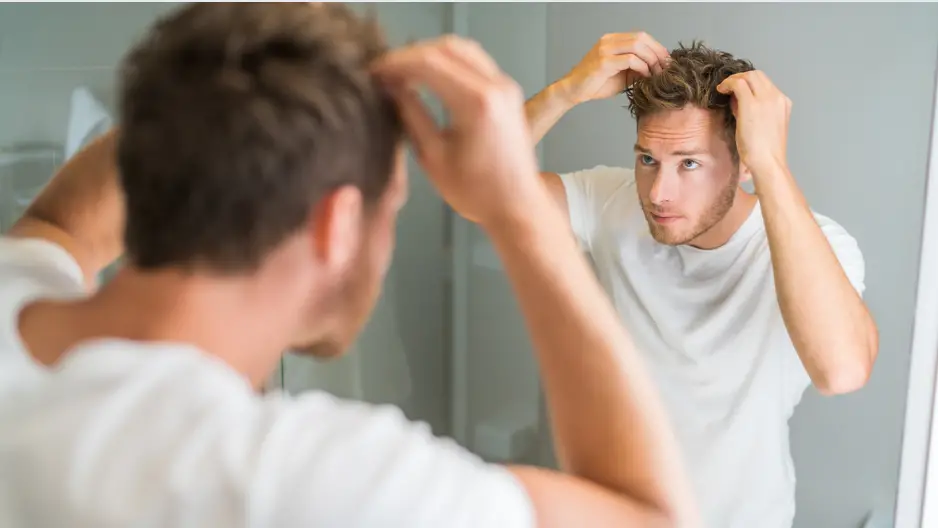
Causes Of Norwood 1 Balding
Some of the common causes of Norwood 1 balding include genetic factors, hormonal imbalances, and nutritional deficiencies. To learn more about the underlying causes and effective treatment options for Norwood 1 hair loss, keep reading!
Genetic Factors
Male pattern baldness, including Norwood 1 balding, is largely influenced by genetic factors. Researchers have identified several genes associated with hair loss and built a genetic score to predict the likelihood of developing male pattern baldness. This means that if you have family members who suffer from hair loss, you may be at a higher risk for experiencing it yourself.
While genetics play a significant role in male pattern baldness, hormonal imbalances and environmental factors can also contribute to hair loss. Hormonal imbalances like high levels of dihydrotestosterone (DHT) can lead to miniaturization of hair follicles and eventual balding. Nutritional deficiencies or stress can also exacerbate existing patterns of hair loss.
It’s important to understand the underlying causes of Norwood 1 balding so that effective treatment options can be explored. Prescription medications like Finasteride or Minoxidil are commonly used to slow down the progression of male pattern baldness caused by hormonal imbalances. Additionally, topical solutions like DHT blocker shampoos and supplements may help prevent further thinning of hair for those with genetic predisposition to male pattern baldness.
Hormonal Imbalances
Male pattern baldness, including Norwood 1 balding, is often caused by a combination of hormonal imbalances and genetic predisposition. Androgens are male hormones that play a significant role in hair follicle development and growth. However, when there is an excess of these hormones or if they are not regulated appropriately, it can lead to hair loss. Hormonal imbalances such as increased dihydrotestosterone (DHT) levels can cause miniaturization of hair follicles and eventually result in Norwood 1 balding.
In addition to DHT imbalance, cortisol – the stress hormone – also plays a role in male pattern baldness. Elevated levels of cortisol can weaken hair follicles leading to shedding or thinning out of the hair. Scientific evidence suggests that prolonged periods of high-stress situations increase cortisol levels; therefore, men experiencing chronic stressors may be at higher risk for male pattern baldness.
It’s important to note that hormonal imbalances aren’t exclusive to men; women also experience them through various stages in their lives which could lead to female pattern baldness. Common causes include fluctuating estrogen patterns during pregnancy and postpartum period or after discontinuation of birth control pills. Additionally, women with endocrine disorders like Polycystic Ovary Syndrome (PCOS) tend to have elevated testosterone levels which could potentially cause cicatricial alopecia resulting from scarring on the scalp due to inflammation around affected hair follicles.
Nutritional Deficiencies
One of the causes of early stages of male pattern baldness, such as Norwood 1 Balding, can be attributed to nutritional deficiencies. A balanced diet that includes essential vitamins and minerals is crucial for healthy hair growth. It’s important to consume nutrient-rich foods such as leafy greens, nuts, and fish regularly. In particular, vitamin D has been associated with various hair loss disorders; a deficiency in this vitamin may lead to hair thinning and shedding.
Aside from dietary intake, taking nutritional supplements like biotin or omega-3 fatty acids can also help maintain healthy hair growth. However, it’s always best to consult with a healthcare provider before starting any supplementation regimen. Ultimately, establishing a consistent and nutritious eating habit combined with proper supplementation could prevent further progression of Norwood 1 Balding while promoting fuller and thicker hair growth over time.
Treatment Options For Norwood 1 Balding
There are various treatment options for Norwood 1 hair loss, including prescription medications like Finasteride or Minoxidil, topical solutions and hair loss products such as DHT blocker shampoo and supplements. To learn more about prevention and maintenance of Norwood 1 balding, keep reading!
Hair Transplantation
Hair transplantation is a popular option for people with hair loss, but it’s not usually recommended for Norwood 1 balding. This is because Norwood 1 only involves slight hairline recession and doesn’t result in significant hair loss at the top of the head. Hair transplant procedures typically involve taking hair from one region of the scalp and transplanting it to another area that has experienced significant hair loss. However, since Norwood 1 only affects a small portion of the scalp, there may not be enough donor hairs available to perform the procedure.
For those with Norwood 1 balding looking for treatment options, prescription medications like Finasteride or Minoxidil are more commonly used as they help prevent further hair loss and promote regrowth. Topical solutions such as DHT blocker shampoo or supplements are also good alternatives to help maintain healthy hair growth. It’s important to note that not everyone experiencing stage one of male pattern baldness requires immediate intervention through medication or active treatments, seeing a dermatologist can provide clarity on what treatment would suit you best based on your individual situation rather than self-diagnosis.
Prescription Medications, Such As Finasteride Or Minoxidil
Prescription medications such as Finasteride and Minoxidil are among the most popular treatments for Norwood 1 balding or Androgenic Alopecia. Finasteride works by blocking DHT, a hormone responsible for hair loss, while Minoxidil helps to increase blood flow to hair follicles. These drugs have been approved by the FDA and are backed by scientific research.
According to a study, around 80% of patients treated with Finasteride experienced some form of hair growth compared to only 52% in other treatments. Meanwhile, Minoxidil has also shown promising results in clinical trials, with visible hair regrowth seen in up to 40% of users after three months of use. It’s essential to note that these medications can take several months before any noticeable effects on hair regrowth show up.
It’s important to consult a doctor before starting any medication treatment plan as there may be side effects or drug interactions that need consideration. Additionally, these medications may not be suitable for everyone due to underlying medical conditions or age-related factors. However, when prescribed appropriately and used correctly, prescription medications like Finasteride and Minoxidil offer hope for those looking for effective solutions against Norwood stage 1 balding.
Topical Solutions And Hair Loss Products
There are a variety of topical solutions and hair loss products that can be used to treat Norwood Stage 1 hair loss. Here are some popular options:
1. DHT blocker shampoo: This type of shampoo works by reducing the production of DHT, a hormone which can contribute to hair thinning and balding.
2. DHT blocker supplement: Similar to the shampoo, these supplements work to block the production of DHT in the body.
3. Topical minoxidil: Minoxidil is an FDA-approved medication that has been shown to promote hair growth in men with androgenetic alopecia (male pattern baldness). It is applied topically directly to the scalp.
4. Low-level light therapy (LLLT): LLLT involves exposing the scalp to low-power lasers or LED lights in order to stimulate hair growth.
5. Hair loss concealers: These products can help cover up thinning areas of hair and create the appearance of fuller hair.
It’s important to remember that while these products may be effective for some individuals, they may not work for everyone. It’s always best to consult with a healthcare provider or dermatologist before starting any new treatments for hair loss.
DHT Blocker Shampoo
A popular approach for treating hair loss is to use a DHT blocker shampoo. These shampoos are designed to reduce the levels of dihydrotestosterone (DHT) on the scalp, which can contribute to hair loss. By blocking DHT, these shampoos may slow down or even reverse hair loss in some people. However, it’s important to note that using a DHT blocker shampoo alone may not be enough to completely stop hair loss.
While there is no direct mention of how effective a DHT blocker shampoo is for Norwood 1 balding specifically, they are often recommended as part of an overall hair care routine for reducing shedding and promoting healthy hair growth. Additionally, many users report positive results from using these shampoos alongside other treatments such as prescription medications or topical solutions.
It’s worth noting that while some DHT-blocking shampoos claim to be all-natural or organic, they still contain active ingredients like ketoconazole and saw palmetto extract that have been shown to effectively reduce DHT levels on the scalp. As with any type of treatment, it’s important to do your research and consult with a healthcare professional before starting any new regimen.
DHT Blocker Supplement
One of the treatment options for Norwood 1 balding is a DHT blocker supplement. Dihydrotestosterone (DHT) is a hormone that contributes to hair loss in men with androgenetic alopecia, including those in the early stages like Norwood 1. DHT blockers work by inhibiting the production of this hormone, thereby reducing hair loss and promoting hair growth. Some popular natural DHT blocking supplements include saw palmetto, pumpkin seed oil, and pygeum bark extract. Studies have shown that these supplements can be effective in treating male pattern baldness.
It’s important to note that while DHT blockers may help slow down or stop hair loss, they are not guaranteed to regrow lost hair on their own. They work best in combination with other treatments like prescription medications or topical solutions. It’s also crucial to consult with a healthcare professional before starting any new supplement regimen to ensure safety and effectiveness for one’s specific condition and medical history.
Prevention And Maintenance Of Norwood 1 Balding
To prevent further hair loss and maintain healthy hair, practicing good hair care habits, eating a balanced diet with nutritional supplements, regular exercise, and managing stress are all essential. Want to learn more about how you can preserve your Norwood 1 hairline? Keep reading!
Healthy Hair Care Practices
Healthy hair care practices are essential for preventing and maintaining Norwood 1 balding. Here are some tips:
1. Avoid harsh styling products and excessive heat styling, which can damage hair and lead to breakage.
2. Use a gentle shampoo and conditioner that is formulated for your hair type, and avoid over-washing your hair.
3. Eat a balanced diet that includes plenty of protein, vitamins, and minerals to support healthy hair growth.
4. Protect your scalp from sunburn by wearing a hat or using a sunscreen spray designed for the scalp.
5. Consider taking supplements that support healthy hair growth, such as biotin or vitamin D.
6. Manage stress levels through techniques like exercise, meditation, or therapy as stress can contribute to hair loss.
7. Regularly trim your hair to prevent split ends and breakage.
By incorporating these healthy hair care practices into your daily routine, you can help prevent further hair loss and promote overall hair health.
Balanced Diet And Nutritional Supplements
Maintaining a well-balanced diet is essential in preventing Norwood 1 balding. Consuming foods that are rich in vitamins, minerals and antioxidants can help keep your hair healthy and promote growth. Foods such as leafy greens, fruits, nuts and whole grains contain vitamin C which helps increase collagen production, promoting stronger hair follicles.
In addition to eating a balanced diet, taking supplements such as biotin or zinc can also aid in the prevention of Norwood 1 balding. Biotin is a B-vitamin that helps strengthen hair strands while Zinc aids in the regulation of hormones which can contribute to hair loss if imbalanced.
It’s important to note that some dietary supplements may interact with medications you’re taking or existing health conditions so it’s recommended to consult with your physician before adding any new supplements to your routine.
Regular Exercise
In addition to a balanced diet and proper hair care, regular exercise can help prevent and maintain Norwood 1 balding. Exercise helps with blood circulation, delivering necessary nutrients to the hair follicles for proper growth. It also helps manage stress levels, which is known to contribute to hair loss. High-stress levels lead to an increase in cortisol production, a hormone that contributes to thinning hair.
Exercises that focus on strengthening the neck and scalp muscles can also be beneficial for maintaining healthy hair. Yoga poses such as downward dog or headstands may help increase blood flow to the scalp, promoting healthy hair growth.
However, it’s important not to overdo it with exercise as high-intensity workouts can cause temporary hormonal imbalances that could result in hair fall-out. Moderate exercises like jogging or cycling are recommended for optimal health benefits without risking negative effects on your crowning glory.
Managing Stress And Mental Health
Stress and mental health play a significant role in hair loss, particularly Norwood 1 Balding. High levels of stress can cause hormonal imbalances that trigger male pattern baldness. Therefore, managing your mental health is crucial to preventing or reducing the risks of Norwood 1 Balding. Simple lifestyle changes like practicing relaxation techniques such as meditation, yoga, exercise, or seeking therapy from a professional can significantly reduce stress levels.
It’s also essential to maintain a healthy diet full of vitamins and minerals known to promote hair growth while avoiding processed foods that may exacerbate inflammation in the body. Additionally, getting enough sleep each night and engaging in self-care activities such as spending time outdoors or with loved ones can help alleviate stress and promote overall well-being. By taking care of your emotional and physical health, you can reduce the risk of developing Norwood 1 Balding while improving your quality of life.
Conclusion: Understanding Norwood 1 And Preventing Male Pattern Baldness
In conclusion, Norwood 1 on the Norwood Scale is not considered balding but rather a natural part of hair maturation. However, it is important to keep an eye on any signs of hair loss and take preventative measures to avoid further progression into more severe stages of male pattern baldness.
This can include maintaining healthy hair care practices, following a balanced diet with necessary supplements, regular exercise, as well as managing stress and mental health. In some cases where there is significant hair loss in men, treatments such as prescription medications or topical solutions may be recommended by a healthcare professional.
Understanding the Norwood Scale can also help diagnose and track the progression of male pattern baldness for appropriate treatment options such as scalp micropigmentation or restoration procedures. Remember that prevention is key when it comes to maintaining a full head of healthy hair!
Source URLs
- https://www.ncbi.nlm.nih.gov/pmc/articles/PMC4812885/
- https://pubmed.ncbi.nlm.nih.gov/3900155/
- https://www.ncbi.nlm.nih.gov/pmc/articles/PMC4740347/
- https://www.ncbi.nlm.nih.gov/pmc/articles/PMC9298335/
- https://www.medicalnewstoday.com/articles/327001
- https://www.ncbi.nlm.nih.gov/pmc/articles/PMC5916388/
- AI Powered Bald Filter Online 2024: See Yourself with No Hair! - January 19, 2024
- Harklinikken Bad Reviews 2024: Analyzing Negative Feedbacks - January 18, 2024
- How to Get the Alex Eubank Hair | Step-By-Step Tutorial 2024 - January 18, 2024

